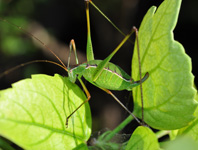Abstract
Many insects are reported to damage cultivated chestnut (Castanea sativa Mill.; Fagaceae) in Italy, but the most important pests of chestnut fruits are weevils (Curculio elephas Gyll. and Curculio glandium Marsh.; Curculionidae) and tortricid moths (Pammene and Cydia; Tortricidae) (Pollini, 1998, Speranza, 1999). The larvae of the tortricid pests develop internally, tunnelling in the fruits and eating the endocarp (Rotundo et al. 1991), which significantly reduces nut quality and commercial value. The most damaging tortricid moths in the Italian chestnut industry are Pammene fasciana (Linnaeus) (the early chestnut moth), Cydia fagiglandana (Zeller) (the intermediate chestnut moth), and Cydia splendana (Hübner) (the late chestnut moth) (Pedrazzoli et al. 2012). Pammene castanicola Trematerra & Clausi, 2009 was recently described from chestnut woods near Etna Vulcan, Sicily (Trematerra and Clausi 2009), and it is known only from the vicinity of the type locality. It is similar to Pammene fasciana in morphological and biological features, and it was previously misidentified as P. fasciana. We provide observations on the biology and larval development and present detailed descriptions and illustrations of the mature larva of P. castanicola, with comments on the differences between P. castanicola and P. fasciana.
References
Brown, J.W. & Komai, F. (2008) Key to larvae of Castanea-feeding olethreutinae frequently intercepted at U.S. ports-of-entry (Lepidoptera: Tortricidae). Tropical Lepidoptera Research, 18, 2–4.
Grimes, L.R. & Neunzig, H.H. (1986) Morphological survey of the maxillae in the last stage larvae of the suborder Ditrysia (Lepidoptera) palpi and mesal lobes (laciniogaleae). Annals of the Entomological Society of America, 79, 489–526.
http://dx.doi.org/10.1093/aesa/79.3.491Hinton, H.E. (1946) On the homology and nomenclature of the setae of Lepidoptera larvae, with some notes on the phylogeny of the Lepidoptera. Transactions of the Royal Entomological Society of London, 97, 1–37.
http://dx.doi.org/10.1111/j.1365-2311.1946.tb00372.xKomai, F. (1999) A taxonomic review of the genus Grapholita and allied genera (Lepidoptera: Tortricidae) in the Palaearctic region. Entomologica Scandinavica Supplement, 55, 1–226.
MacKay, M.R. (1959) Larvae of the North American Olethreutidae (Lepidoptera). Canadian Entomologist Supplement, 10, 338 pp.
Pedrazzoli, F., Salvadori, C., De Cristofaro, A., Di Santo, P., Endrizzi, E., Sabbatini Peverieri, G., Roversi, P.F., Ziccardi, A. & Angeli, G. (2012) A new strategy of environmentally safe control of chestnut tortricid moths. IOBC/WPRS BULLETIN, 74, 117–123.
Pollini, A. (1998) Manuale di Entomologia Applicata. Edagricole, 1462 pp.
Rotundo, G., Giacometti, R. & De Cristofaro A. (1991) Sulla dannosità dei principali fitofagi del frutto del castagno in alcune aree dell'Italia meridionale. Atti XVI Congresso Nazionale Italiano di Entomologia, Bari-Martina Franca (TA), 23-28 settembre, 771-779.
Speranza, S. (1999) Chestnut pests in Central Italy. Acta Horticulturae, 494, 417–424.
http://dx.doi.org/10.17660/ActaHortic.1999.494.62Swatschek, B. (1958) Die larval systematik der wickler (Tortricidae and Carposinidae) aus dem zoologischen Institut der Universitat Erlangen. Akademie-Verlag, Berlin, 269 pp.
Trematerra, P. & Clausi, M. (2009) Pammene castanicola sp.n. a new Lepidoptera Tortricidae from Sicily. Bollettino di Zoologia Agraria e di Bachicoltura, 41 (2), 59–64.

